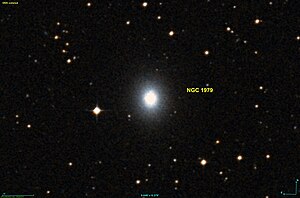NGC 1979
| Galaxy NGC 1979 |
|
|---|---|

|
|
| AladinLite | |
| Constellation | Hare |
|
Position equinox : J2000.0 , epoch : J2000.0 |
|
| Right ascension | 05 h 34 m 01.1 s |
| declination | -23 ° 18 ′ 36 ″ |
| Appearance | |
| Morphological type | SA0: |
| Brightness (visual) | 11.8 mag |
| Brightness (B-band) | 12.8 mag |
| Angular expansion | 1.8 ′ × 1.8 ′ |
| Surface brightness | 13.1 mag / arcmin² |
| Physical data | |
| Redshift | 0.005667 ± 0.000060 |
| Radial velocity | 1699 ± 18 km / s |
|
Stroke distance v rad / H 0 |
(69 ± 5) · 10 6 ly (21.1 ± 1.5) Mpc |
| history | |
| discovery | William Herschel |
| Discovery date | November 20, 1784 |
| Catalog names | |
| NGC 1979 • PGC 17452 • ESO 487-024 • MCG -04-14-004 • 2MASX J05340112-2318361 • SGC 053156-2320.5 • GC 1182 • H III 240 • GALEX ASC J053401.07-231836.5 • LDCE 399 NED002 | |
NGC 1979 is an elliptical galaxy of Hubble type E / S0 in the constellation Hare on southern sky . It is estimated to be 69 million light years from the Milky Way and about 50,000 light years in diameter.
The galaxy is a member of the NGC 1964 group , which also includes NGC 1964 , IC 2130, and IC 2137 .
The object was discovered by Wilhelm Herschel on November 20, 1784 .
